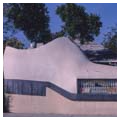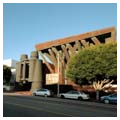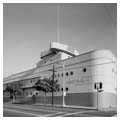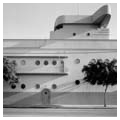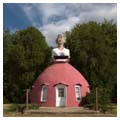America’s fascination with mimetic architecture began with an elephant. In 1881, James Lafferty built a colossal tin-plated pachyderm topped by a canopied howdah to attract customers to his seaside real estate venture in Margate, New Jersey. Lafferty took prospective clients up to the howdah to view land parcels and used the belly of the beast for his business offices. Because it is in the shape of an animal, Lafferty’s Elephant Bazaar (now known as Lucy the Elephant) is an example of zoomorphic architecture, but more broadly, it is an example of novelty architecture or what architectural historian David Gebhard labelled “programmatic architecture”: a building type that uses the mimetic, sculptural form of the structure to communicate its contents. Architectural theorist-practitioners Robert Venturi and Denise Scott-Brown famously called such buildings “ducks” after a duck-shaped Long Island shop in which ducks and duck eggs were sold. Programmatic architecture is just one building type in the taxonomy of the American roadside that includes gas stations, supermarkets, motels, and restaurants.
The roots of American programmatic architecture reach back to the garden follies of seventeenth-century Baroque Italy and eighteenth-century Enlightenment England and France. By way of an example, Count Orsini populated his enchanted garden at Bomarzo, Italy, with stone dragons, sirens, and a giant whose head served as a dining pavilion. British aristocrats returning from their Grand Tours imitated such conceits on their estates, manifesting erudite cultural allusions and literary jokes to visitors; the landed gentry built sham classical temples, pyramids, and medieval ruins that were not only decorative additions to the garden but places in which to take refreshment. Perhaps the first example of truly programmatic architecture, that is, of a building announcing its purpose through shape and form, was the pineapple-shaped pineapple growing house of 1761 by an unknown builder-architect for John Murray at Dunmore House in Scotland.
The French referred to such architecture as “architecture parlante” or speaking architecture. A good example is Claude-Nicholas Ledoux’s unbuilt woodcutter’s house in the shape of a pyramid of logs, which he designed in the 1770s for the Royal Salt Works in Arc-et Senans. Lafferty’s seaside elephant followed the landscape architecture tradition in that it was an “eye catcher” that compelled a closer look, but unlike the garden pavilions of wealthy and learned Europeans, Lafferty was entirely motivated by commercial gain. Lafferty enjoyed enough financial success with his experimental advertisement that he then built the Elephantine Colossus hotel at Coney Island and another elephant-shaped structure at Cape May, New Jersey, south of Margate.
The race to be first is often won on a technicality and Lafferty’s Margate elephant did indeed beat out the Statue of Liberty as America’s first mimetic building, even though Lady Liberty’s torch-bearing hand was first unveiled at the Philadelphia Centennial Exhibition in 1876; however, it was another five years before the completed colossus was dedicated. Repurposed buildings and materials from the Philadelphia Centennial were later used in the construction of America’s first amusement destination at Coney Island, New York. Amusement parks became so popular that when Chicago’s 1893 World’s Columbian Exposition was being planned, the exposition committee determined that an entire section of the fair should be devoted to amusement. The Midway Plaisance contained the first Ferris Wheel, experimental moving picture shows, and the Street in Cairo, in which paying visitors could walk through full-scale replicas of Egyptian alleyways and witness performances of belly dances and wedding processions.
World’s fairs like those in Philadelphia and Chicago became the testing grounds for experimental building materials and techniques such as gunnite, spray paint, and neon lights—all of which played important parts in mimetic roadside buildings and their accompanying signage. The vital link between world’s fairs and programmatic architecture came at the San Francisco Pan-Pacific International Exposition of 1915, when film director D.W. Griffith hired the builders of giant plasterwork three-dimensional signs (including two 20-foot-high, trumpet-playing clowns advertising the “Bowls of Joy” tilt-a-whirl and the pair of colossal plasterwork ostriches fronting an ostrich farm) to recreate ancient Babylon for his film Intolerance.
A true craze for programmatic architecture began in the 1920s, at a time when automobiles became more affordable for the middle classes and when the standard American work week was reduced to five days. This meant that middle-class families had both newfound leisure time and the means by which to spend it, namely touring in their automobile. This golden age lasted until World War II, and Southern California was its epicenter. Hollywood was the capital of make-believe and Los Angelenos embraced buildings in the shape of Dutch windmills, where they purchased baked goods, and giant chili bowls, where they ate lunch. One of the first programmatic buildings was the Brown Derby restaurant on Wilshire Boulevard, built in 1926 in the shape of a colossal derby hat. Despite its associations with Hollywood’s stars (it was must-see destination for Lucy Ricardo on the I Love Lucy television show), the Brown Derby was bulldozed in the 1980s. Scaled-down recreations of the Brown Derby are currently fixtures at the overtly nostalgic Disney California Adventure Parks.
Like James Lafferty, Los Angelenos sought patents for their unique structures, which included the mimetic Tamale diner in 1928 and the owl-shaped building (with Cadillac headlamps for eyes) that housed the Hoot Hoot I Scream for Ice Cream stand in 1930. Dog-shaped hot dog stands were such an obvious visual pun that two variations were built in 1928. While the original Bulldog Café was demolished, its simulacrum appeared in the 1991 Disney film The Rocketeer and went on to live its afterlife as a stop on the Disney-Universal Studios backlot tour. Nonsense was the rule of the roadside; where else would you find a landlocked ocean liner (1936, Robert Derrah)—one that dispenses Coca-Cola!—except in Los Angeles?
The rest of the country jumped on board the Hollywoodland express. Martin Mauer built the Long Island Duck in 1931. Like many programmatic buildings, it was made of concrete laid on a wire form over timber framing. This combination of materials allowed builders to create imaginatively shaped structures that proved to be quite resilient to time and the elements. Mauer, in the do-it-yourself spirit of the day, used automotive headlamps for the eyes of his zoomorphic roadside stand. By the 1960s such whimsies were perceived as roadside blight by the likes of architectural curator and critic Peter Blake, who called out the Long Island Duck in his 1964 book, God’s Own Junkyard, attracting the attention of a number of critics and theorists, including Robert Venturi and Denise Scott-Brown, who defended the duck-shaped shop as an example of American signage of the purest sort. Locals took up the cause of the Long Island Duck so that it was eventually saved, restored, and listed on the National Register of Historic Places in 1997. Today it survives as a curio shop.
This arc from faddish novelty architecture to neglected roadside blight to nostalgia-laden local landmark is echoed across the country. Although moved from its original location, one of William Alston’s patented pig-shaped barbecue stands of 1939 survives as a neighborhood marker in San Antonio, Texas. And of the seven scallop-shaped Shell Service Stations built in 1930 by Joe H. Glenn and Bert L. Bennet in and around Winston-Salem, North Carolina, the one that survives has been lovingly restored and repainted in its original trademark brilliant red and yellow hues. All of these buildings were erected with the express intention of luring drive-by customers.
Inspired by the programmatic architecture he saw in Southern California, Frank Redford built Wigwam Village in Horse Cave, Kentucky, in 1933. When the highway was moved three years later, Redford built Wigwam Village No. 2 in Cave City, with the same 52-foot-high dining room and 15 “sleeping rooms,” as Redford liked to call them. Based on Hollywood stereotyping of Native Americans, the ferro-concrete sleeping rooms are modeled on the teepees of the Southwest Plains tribes rather than the wigwams of the original inhabitants of Kentucky. Franchises of Wigwam Village were built along major tourist routes in Florida, Louisiana, and Alabama, with Redford himself adding the last outpost in Rialto, California, in 1946. Redford’s Wigwam Nation survives along Historic Route 66, offering pseudo-pioneers the chance to put down stakes in fantasy wigwam-teepees as they migrate along the great east-west trail known fondly as the Mother Road. If Redford drew inspiration from Hollywood, it seems only fair that Hollywood should eventually pay homage to Wigwam Village; Pixar Films immortalized Wigwam Village No. 6 in Holbrook, Arizona, as the Cozy Cone Motel in the 2006 film Cars, and in a dizzying sleight of hand, the animated version of the Wigwam Village is now a real concession at Disney’s California Adventure Parks. Such inversions could only make sense in Disneyland, which is an entire fantasyland based on the architectural gymnastics of rides posing as buildings.
Walt Disney opened the gates to his Anaheim, California, amusement park in 1955 with a simulacrum of the nineteenth-century Bavarian Neuschwanstein Castle as its central attraction, reimagined by Disney as Sleeping Beauty’s Castle. To get to the Castle those early visitors walked along Main Street—a reduced-scale replica of the American commercial centers that, at the time, were being abandoned for new and modern suburban shopping malls. Disney brought his animated worlds to life in his amusement rides, including, for instance, the seemingly abandoned New Orleans–style Haunted Mansion, opened in 1969. Disney’s personal nostalgia for bygone eras continues to motivate Disney Imagineers; the latest trend at Disney parks includes the programmatic architecture of the American roadside in the California Adventure Parks. Visitors can now purchase camera gear in a replica of the 1926 Los Angeles camera-shaped camera shop called The Dark Room and have dinner in a simulacrum of the original Brown Derby diner.
Michael Eisner ushered in an era of nostalgic but also witty and even erudite programmatic architecture at Disney when he was CEO from 1984 to 2004, employing “starchitects” who incorporated the roadside idiom into their designs; a version of Mickey Mouse’s wizarding hat from Fantasia became the entryway to the Disney Animation building (1994) by Robert A.M. Stern, its colossal scale and prominent position making it easy to spot from the nearby freeway.
Like Disney, corporate Las Vegas embraced and even enlarged the programmatic genre, to a scale suited to both the rocketing speeds of postwar automobiles and the vastness of the Nevada desert. Robert Venturi and Denise Scott-Brown drove with their architecture students to Las Vegas in 1968, the same year that the first truly mimetic casino, Circus Circus, was erected on the Strip; the colossal building takes the form of a red-and-white–striped circus tent. Circus Circus architects Rissmann and Rissmann went on to design the landlocked riverboat-shaped Holiday Casino further down the Strip in 1990, the same year that Veldon Simpson designed the Neuschwanstein Castle-inspired Excalibur Hotel. The 1990s represents the apogee of Las Vegas’s programmatic craze with examples including the pyramidal Luxor (1993); Paris Las Vegas (1999), with its mash-up of Paris buildings huddled under a slightly undersized Eiffel Tower; and the Venetian (1999), with its architectural homage both inside and out to that city (appropriately omitting Saint Mark’s Basilica). And while these buildings are not selling the thing for which they are shaped, they are selling the glamour and exoticism associated with the originals.
Programmatic architecture was never really in fashion and thus, it could never really go out of fashion. Idiosyncratic American shopkeepers like the Bondurant brothers built their massive mortar and pestle–inspired pharmacy in Lexington, Kentucky, in 1974. Longaberger Company’s former headquarters was tucked inside a seven-story building known as The Big Basket (1995–1997), in Newark, Ohio. Big Basket architect Friedrich Bohm expressed the commercial impetus behind the mimetic building, calling it “a gigantic billboard.” In 1991 Frank O. Gehry, with sculptors Claes Oldenburg and Coosje van Brueegen, built a colossal pair of binoculars to house the offices of the Chiat/Day advertising firm in Santa Monica, California, making Gehry the first starchitect to embrace the roadside idiom with all of its inherent humor. If programmatic architecture was originally about eye-catching uniqueness, chain entertainment franchises that populate tourist meccas like Branson, Missouri, and Pigeon Forge, Tennessee, have added a twist to the genre by making multiples, such as the twin Titanic Museum Attractions built in both landlocked towns in 2006.
Preservation efforts began to bear fruit in 1976, when Lucy the Elephant became the first programmatic building listed on the National Register of Historic Places. And although many roadside buildings have been lost to the wrecking ball or the ravages of time, citizen groups and whole communities have come to think of them as worthy of saving. Recent waves of entrepreneurs have added a layer of collective nostalgia for a “golden age” when the automobile tourist could still be surprised and delighted by a chance encounter with a bizarre building. For example, in 2010 Los Angeles designated The Idle Hour (1941) a Historic-Cultural Monument. The enormous whiskey barrel–shaped bar, which had long since fallen into disrepair, was purchased in 2015 by a conservation-minded restaurant group who lovingly restored it, and included a replica of the 1928 Bulldog Café (salvaged from the Peterson Automotive Museum) in the beer garden. The juxtaposition of a restored and landmarked original building and a replica of a destroyed mimetic building—with their overlapping levels of history, fakery, and mimesis—is the perfect Hollywood ending.
References
Andrews, J. J. C. The Well-Built Elephant and Other Roadside Attractions: A Tribute to American Eccentricity. 1st ed. New York: Congdon and Weed, 1984.
Butko, Brian, and Sarah Butko. Roadside Giants. Mechanicsburg, PA: Stackpole Books, 2014.
Gebhard, David, and Harriette Von Breton. L.A. in the Thirties, 1931-1941. Layton, UT: Peregrine Smith, 1975.
Heimann, Jim. California Crazy: American Pop Architecture. Köln: Taschen, 2018.
Writing Credits
If SAH Archipedia has been useful to you, please consider supporting it.
SAH Archipedia tells the story of the United States through its buildings, landscapes, and cities. This freely available resource empowers the public with authoritative knowledge that deepens their understanding and appreciation of the built environment. But the Society of Architectural Historians, which created SAH Archipedia with University of Virginia Press, needs your support to maintain the high-caliber research, writing, photography, cartography, editing, design, and programming that make SAH Archipedia a trusted online resource available to all who value the history of place, heritage tourism, and learning.

